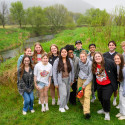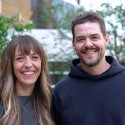Facility to bridge gap between discovery, therapy
A new Waisman Center facility will help scientists overcome one of the major hurdles of biomedical research: Taking a promising discovery from the laboratory bench to the medical environment.
The Waisman Clinical Biomanufacturing Facility is designed to help researchers demonstrate the human health potential of their discoveries by providing them with the sophisticated, clean and highly controlled tools needed for early-phase clinical trials.
 Lisa Nanstad, assistant director of the Waisman Center expansion project, shows off progress on a fourth-floor clinical facility that will be part of the seven-story research wing being added to the center on Highland Avenue on the west end of campus. Space is set aside for a new Gene Therapy Research Program, an Integrated Imaging Center and early intervention programs. Photo: Jeff Miller
|
University scientists working on the leading edge of biomedical research, in areas such as embryonic stem cells and gene therapy, normally require a private industry sponsor to attempt Phase I clinical trials, the first step in proving a treatment’s value. Terrence Dolan, director of the Waisman Center, says the in-house alternative will give these emerging research areas on campus a better shot at reaching the goal of human medical applications.
“We have a number of cancer gene therapy projects on campus now that will eventually use this facility, and many other potential projects in the biosciences,” Dolan says. “We will be able to carry out these projects much more independently than we’ve done in the past.”
The facility will formally open in January 2001, but is now seeking research partners in the UW–Madison biosciences community, as well as Wisconsin biotechnology businesses that need a clean biomanufacturing facility to develop clinical applications. The facility will be one of a kind in the Midwest, and will help nurture new spinoff companies in Wisconsin that are in the business of developing biological therapies.
The facility will support what is commonly called translational research, which helps science bridge the gap between drug discovery and development. WCBF will be comprised of ultra-clean, controlled-environment manufacturing rooms that will meet the strict requirements of the Food and Drug Administration for developing materials for human clinical trials.
Included are production suites for mammalian- and microbe-based biopharmaceuticals, including viral and non-viral vectors for gene therapy. A vector is a biological tool that helps integrate therapeutic genetic material into a cell. Another suite will produce cell-based therapies and will be able to develop cell banks for use in treating specific diseases. The facility will also include a quality control lab that provides another layer of testing.
“This facility is going to be able to take genomics research advances directly into therapy in Wisconsin, without going outside the state,” says Derek Hei, the technical director of the facility.
Hei says the WCBF staff is ready to work with university scientists whose research may be headed for a clinical trial, either now or down the road. He says the staff can help scientists take the necessary steps to prepare their work for a clinical trial.
“We’re basically going out to researchers and asking, “What do you need to get your ideas from the lab bench into patients?'” Hei says. “They are answering with two things: One is this facility and the other is greater support for clinical trials.”
James Timmins, program development manager for WCBF, says an economic development story might also emerge as this facility matures. Only a few biotechnology and drug companies in Wisconsin are developing these types of biological interventions, and the center could spark new business opportunities.
University faculty will always be the first clients of the facility, but Timmins says WCBF can also offer contractual services to tenants of University Research Park and other state biotechnology companies.
In its first year, Dolan says the majority of projects in the facility will be for new cancer therapies. One project will be a new breast cancer gene therapy developed by oncologist David Mahvi. The project will be the first such clinical trial on campus done without a corporate sponsor.
Another researcher to benefit from WCBF is pediatrics professor Jon Wolff, who has developed gene therapies for the treatment of Duchenne’s Muscular Dystrophy. Wolff’s laboratory is developing a new non-viral gene therapy technique in which the genetic material can be injected into the bloodstream. The goal is to provide treatment throughout the body. The future treatment may help produce a protein called dystrophin, the absence of which causes muscular dystrophy’s degenerative effects.
Some promising biomedical research areas that may reach clinical trial phase soon include work on insulin resistance, overproduction of cholesterol, myelin disorders such as multiple sclerosis, and development of synthetic biomaterials for surgical applications.
In addition to Mahvi and Wolff, steering committee members include: oncologist Mark Albertini; biochemist Alan Attie; medical microbiologist Curtis Brandt; veterinary medicine professor Ian Duncan; pharmacy assistant professor John Kao; pediatrics professor Paul Sondel; stem cell researcher James Thomson; and cardiologist Matthew Wolff.
Dolan says many rare childhood genetic diseases may be highly responsive to gene therapy. But some of them affect so few children, less than one in 50,000 in the population, that drug companies may not financially support all four phases of clinical trials. In those cases, WCBF may be able to see through the entire process and make these therapies uniformly available.
The Waisman Center, which has more than 75 research affiliates, is one of 14 national centers dedicated to research on human development and developmental disabilities. The WCBF is just one part of a new $24 million research wing being added to the Waisman Center, which will include other cutting-edge research services.
Tags: research





